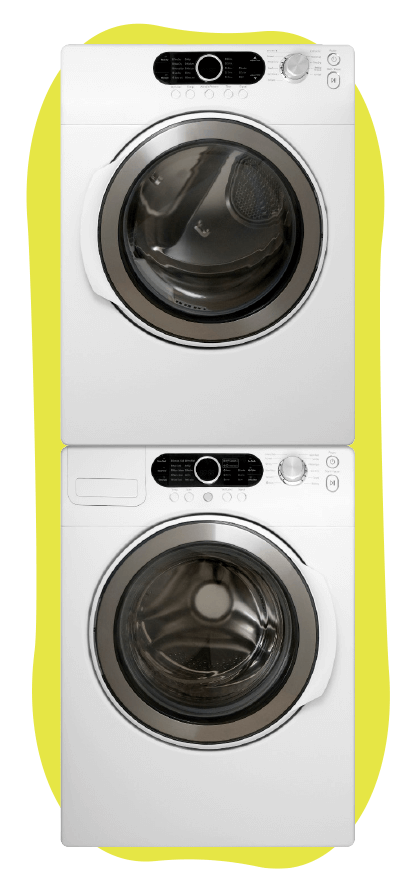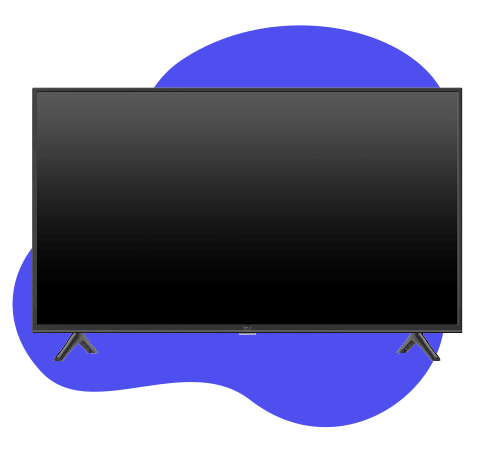Your Life
WHEN IT BREAKS
Your fast-action guide to replacing high-priced home items
The refrigerator just went kaput, and you need to replace it ASAP. No need to worry. We’ve got you covered. It may have been a while since you last shopped for major home items—and a lot has changed. Use this shopper’s guide to get up to speed on the latest models and options for household essentials.

WASHERS AND DRYERS
When washing machines give up the ghost, they typically leave you with a soggy mess. Before that, a bad smell might be a sign it’s time to replace; older units may lose the ability to adequately self-clean. And inner parts can loosen, causing the unit to lose its uniform spinning. Plus there’s lots of water involved with each load; leaks can emerge.
Once washers and dryers wear out, the typical path is to replace with same-size units. But as kids move out, consider downsizing your machines to save money, space and energy usage.
▶︎ Top-loading is back
Though most experts a decade ago would have recommended a front-loading model for maximum efficiency, top-loading models have improved substantially in recent years, making the choice one of personal preference, says Patric Richardson, who hosts The Laundry Guy on Discovery+.
▶︎ So are stackables
Stackable washers and dryers have also improved in recent years, Richardson says, and many side-by-side models are built to stack as well. Another new space-saving design is the all-in-one machine, which can wash and dry clothes without the need to transfer them.
▶︎ Expect more sensors
Today’s washing machines can sense the level of dirt on clothes and the size of the load to determine the appropriate amount of water to use.
That can be confusing at first for folks used to an older machine, who might wonder why the machine doesn’t fill with water. Dryers also now have sensors that automatically adjust the cycle time, based on the size and dampness of the load.
▶︎ No need to agitate
Many of today’s models no longer have an agitator in the middle of the cavity. That can save on water bills, says Andrew Morris, senior manager at the Alliance for Water Efficiency. “Those still work well, and they’re gentler.”
▶︎ WHAT YOU’LL PAY
A matching washer-and-dryer set typically runs $1,000 to $2,300, whether the units are stackable or side-by-side. If you need just one or the other, expect a cost of $700 to $1,300 for a washer or $800 to $1,200 for a dryer, according to data from HomeGuide.com.

REFRIGERATORS
When your refrigerator stops running, you might have to scramble to buy a new one before your food spoils. Nonwarranty repairs are expensive, so buying new is often sensible after a fridge is 8 years old.
Here’s what is new:
▶︎ A different door
Some refrigerator front doors have windows so you can view the contents, while others boast a built-in computer screen for displaying photos and notes. In-door icemakers have evolved as well; higher-end versions offer ice crushed or in crescents, cubes and other shapes for choices when cooling beverages.
▶︎ High-tech cooling
For a price, you can have a fancier interior too. “You can find multipoint LED lighting, flexible shelving, multiple food-specific refrigeration zones and even ethylene gas filters so that the rest of your groceries don’t spoil as fast,” says Honey Homes general manager Andrew Perroy. You can even find models with internal cameras you can access via smartphone to check from the supermarket to see whether you’re out of milk.
▶︎ Lower power needs
Today’s refrigerators are more efficient than those sold five to 10 years ago. While fridges with an Energy Star rating are the most efficient, even a model with average efficiency should deliver energy—and utility bill—savings, says Jill Notini, vice president of communications for the Association of Home Appliance Manufacturers.
▶︎ WHAT YOU’LL PAY
A basic model will cost about $500. Higher-end, tech-enabled models often cost $2,000 to $3,500; top-end units designed to be built into the cabinetry can run as high as $10,000.

TELEVISIONS
TVs don’t break so much as they become obsolete. Or consumers just want to upsize. Either way, TVs are one of America’s favorite splurges; some 40.9 million were sold in the U.S. last year, or roughly 1 for every 8 Americans. Pros suggest upgrading every four to six years; like a computer, older TVs have out-of-date technology that can affect viewing and performance; LED lights can start losing brightness after four years. Here’s what to expect when you shop:
▶︎ Prepare to upsize
Today, the most commonly owned TV is 55 inches (as measured diagonally), but that’s rising fast; 85-inch TVs at home aren’t uncommon, thanks to better flat-screen technology.
▶︎ Focus on two technical standards
TV technology can be a jumble of confusing acronyms: OLED, QLED, LCD, 4K, 8K, HDR and more. Focus on just two qualities. The first is resolution (essentially, the number of pixels on the screen); today’s standard is 4K, which has four times the resolution of HDTV, the gold standard of years past. Though the salesperson might try to steer you to a high-end 8K television, say “no thanks”: There’s really no content available in 8K today. The other thing to look for is “high dynamic range.” TVs that qualify as HDR have much more vivid colors and crisp details. Once you choose a 4K HDR model, the other technical distinctions matter less, says John Couling, senior vice president of entertainment at Dolby Laboratories.
▶︎ TV as internet gateway
A “smart TV” is simply a TV built to connect seamlessly (usually via Wi-Fi, so no cables needed) to your internet service. Smart is the way to go if you want to access any streaming service or view anything that is online. Smart TVs use third-party software, such as Roku or Amazon Fire, which helps you navigate the huge range of available digital content, whether free or purchased.
▶︎ Expect new brands
Shoppers were once encouraged to go with Samsung, LG or Sony for quality sets. But brands from Amazon, Vizio, Hisense and TCL are considered trustworthy. And often, they’re cheaper. Try to look at the TVs side by side to determine which you prefer.
▶︎ One negative: sound
TV makers focus on the visual quality of their products, assuming you’ll likely buy a separate sound system, ranging from a simple soundbar that sits under the TV to elaborate, multispeaker systems.
▶︎ WHAT YOU’LL PAY
A well-equipped 55-inch 4K smart TV can be found for less than $500. Bigger size, better resolution or more features can add significantly to that price tag. But “capabilities found only in top-of-the-line TVs a few years ago are now core offerings in TVs at all prices,” Couling says.

DISHWASHERS
You may be tempted to just wash dishes by hand if your dishwasher breaks. But that’s much less efficient—in terms of electricity and water—than replacing your old one. New dishwashers boast big improvements.
▶︎ Cycles are more efficient
The most efficient dishwashers complete an entire wash using less than 3.5 gallons of water, far less than older models or what you’d use to wash those dishes by hand. “The amount of water that today’s dishwashers use is obscenely low, when you think about the level of cleanliness and sanitation that’s happening,” says Michael Cornell, innovation lab technologist with Asurion, an appliance-repair company based in Nashville, Tennessee.
▶︎ But they take longer
To get that efficiency, dishwashers use recirculation technology with pumps and filters to cut down on the amount of water. Though new technology shortens drying cycles, washing takes more time. A standard dishwasher cycle can take upward of two hours.
▶︎ Seen and not heard
When it comes to noise, dishwashers have improved so much that people can be standing in the kitchen and forget that the machine is running. In addition to better insulation around the unit, the lower noise level reflects a shift from a plastic tub to stainless steel, which better dampens the sound of jetting water.
▶︎ All digital
Like most other home appliances, dishwasher controls have gone digital—some feature more futuristic LCD panels or a touch screen. You’ll need to decide whether you want the controls on the front of your dishwasher or on the top of the door, where they’re concealed when it’s closed. “Having them concealed looks nice,” says Angie Hicks, chief customer officer of Angi (formerly Angie’s List), the home-repair referral company. “But it’s also harder to see how much longer the dishwasher has to go when it’s running.”
▶︎ Ask about extras
An adjustable upper rack provides flexibility with loads made up of different-sized dishes. If that doesn’t come standard, it’s worth asking a salesperson if that feature is available. Also consider an option for a quick-wash cycle. Though these are less energy-efficient, they can be helpful when you’re in a time crunch.
▶︎ WHAT YOU’LL PAY
Prices for most models fall between $400 and $1,200. Expect to pay more for bells and whistles such as Wi-Fi connectivity, dual-drawer design or a third rack for utensils.

TOILETS
When a toilet craps out, you can replace it with one that has upgrades and uses less water, potentially saving big bucks on your monthly water bill.
▶︎ A smaller flush
New toilets use about a quarter of the water of older toilets. “Low flow, initially found only in higher-end toilets, is almost ubiquitous these days,” Perroy says. You can cut water usage even more by looking for the WaterSense label, which indicates the toilet uses only 1.28 gallons per flush. The federal standard is 1.6 gallons; toilets made before 1992 used 3.5 gallons or more.
▶︎ Height choices
The standard toilet height is about 15 inches, but models labeled as “comfort,” “chair” or “easy” rise a couple of inches. “The higher a toilet is, the easier they are to get on and off,” says Mark Collins, chief executive officer of 1-800-Plumber +Air. “If someone has bad knees or a bad back, it would be better to go with a taller toilet.”
▶︎ And for a price, accessories
Today’s toilets can come with built-in bidets, heated seats and even lighting. Some models play music, have motion-activated lids or automatic flushing.
▶︎ WHAT YOU’LL PAY
Basic toilets cost about $300. If you’re interested in a premier brand such as Toto or Kohler with custom features, be prepared to spend upward of $2,000, Perroy says.
Beth Braverman has written for Money and CNBC.com. Chris Morris writes about technology for Fortune and others. Stewart Wolpin is a technology writer whose work has appeared in The New York Times’ Wirecutter and elsewhere.